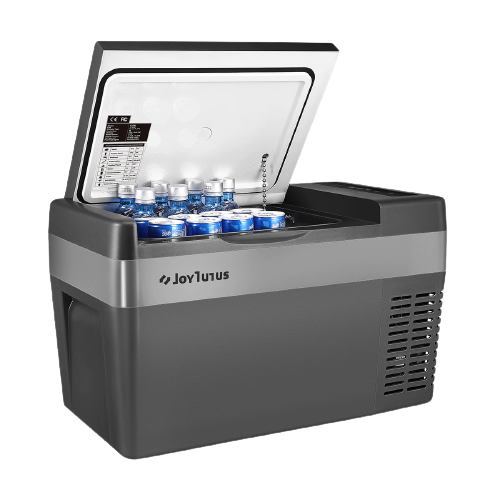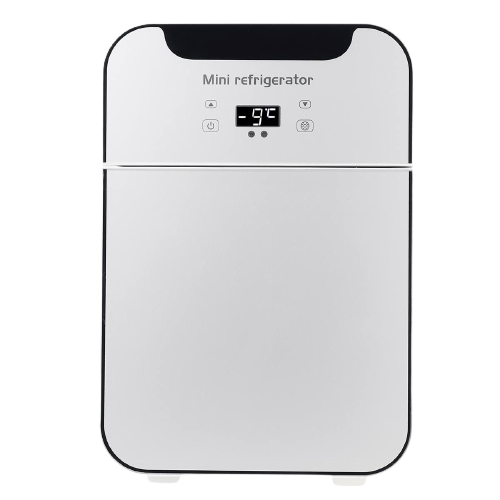-
Cooler
-
Your food and beverages remain fresh with our soft coolers. Convenient, they're ideal for daily life.
-
Your food and beverages stay fresh with our soft coolers. Like insulated bags, they're convenient, available in various sizes. Perfect for everyday use, they simplify the transport of your meals. Healthy Lunch, for healthy eating, wherever you are.
-

Rigid Blue Cooler 10L
Regular price $69.90 USDSale price $69.90 USD Regular priceUnit price per -

High Performance Brown Cooler
Regular price $440.90 USDSale price $440.90 USD Regular priceUnit price per -

High Performance Grey Cooler
Regular price $440.90 USDSale price $440.90 USD Regular priceUnit price per -

White High Performance Cooler
Regular price $440.90 USDSale price $440.90 USD Regular priceUnit price per -

9 Liters Electric Refrigerator - Vehicle
Regular price $390.00 USDSale price $390.00 USD Regular priceUnit price per$595.90 USD -

Electric Cooler 25 Liters - Hot/Cold
Regular price $635.00 USDSale price $635.00 USD Regular priceUnit price per$889.90 USD -

20 Liters Electric Cooler - Car/Home
Regular price $440.90 USDSale price $440.90 USD Regular priceUnit price per -

Electric Cooler Car/Truck 32L - 12V -220V
Regular price $625.00 USDSale price $625.00 USD Regular priceUnit price per$895.50 USD
Keep your food fresh with the soft coolers from Healthy Lunch
Discover our wide selection of coolers to keep your meals cool and warm. Discover our flexible, rigid and electric coolers.
How to choose your cooler ?
When you want to buy a cooler, you have to take several parameters into consideration in order to choose the model that suits you best. We will see together the most important elements to make your choice.
The thermal insulation of your cooler
The most important criterion for most of us is the ability of a cooler to keep food cool or warm. This criterion is also the source of a lot of extraordinary claims from manufacturers, but very few can deliver on their cooling promises. At Healthy Lunch, we are committed to giving you all the information about the heat capacity of our products.
Before choosing your cooler, you will need to define your needs in order to choose the model that best suits you. Do you need a cooler that keeps your food fresh for 4 hours or do you need to store your food for several days? The price and the choice of the model will be different according to these criteria. For a low thermal insulation, you can opt for a soft cooler which will have the advantage of being design and easy to carry thanks to its lightness. And, if you want a cooler that can keep your food and drinks for an entire weekend of camping, a high-performance rigid cooler will be necessary. And, if you often travel by car or truck (road trip for example), an electric or compression cooler could be interesting.
The durability of your cooler
Knowing that your investment will last for years and years of adventures is important for any accessories and items you own. And coolers are no exception. At Healthy Lunch, we spent months subjecting them to extended use and a number of different conditions to see how they held up to the outdoors. Buying a cooler is not a trivial purchase and we want our customers' investment to pay off over time.
The durability of your cooler is therefore a very important consideration and a sturdy cooler will ensure performance for many years. To do this, check the closures on the cooler's lid: is the lid locked or is it just sitting on top? Are the materials used strong or can they break easily? Check these points and if you have any questions, you can write to our customer service.
The ease of use of your cooler
Is your cooler difficult to use? Ease of use is a key factor in your overall satisfaction with a given product. We tested the ease of use of each Healthy Lunch model. In our tests, we evaluated how easy it is to open and close each model: Does the lid stay open when you fully load it? Are the latches easy to operate with a full hand? We also looked at how easy it is to load: Is the configuration conducive to special shaped items? Is the interior high enough for 2-liter bottles of soda or champagne for birthday parties? Does the cooler have convenient features, like a dry bin for items that shouldn't touch ice or soak in ice water?
All of these elements and specifics are good questions to ask and consider when making the best cooler choice.
The portability of your cooler
At first glance, the question of portability seems obvious: wheels? Portable. Small size? Portable. Large capacity? Not so portable. And while this is generally true, it's not always the case.
In our cooler collection, we not only considered these obvious factors in our testing, but we also looked at them in more detail. We took a close look at the design, shape, placement and comfort of each handle when loaded. And we didn't just consider the weight of each cooler, but also what that weight gives you in terms of capacity - in other words, how much are those extra pounds worth? We filled them up and loaded them in and out of the car, drove across beaches, and walked around neighborhoods to see which ones bang against your knees, bite the back of your heels, or form blisters on your palms.
After all these tests, we were able to determine which coolers are the most portable, and we were able to offer you quality models.
The features of your cooler
The little things that make a product easier to use, more suited to your lifestyle, or that help you not have to carry too much stuff with you, can make a difference in your enthusiasm for using your cooler. But not all features, add-ons and extras are created equal and their value may depend on how you intend to use your equipment. In general, you can find the following features: internal baskets or dividers to keep your food fresh the way you want, and the ability to hold dry ice, which extends the cooling capacity. Other features, still useful but more specific to certain styles of use, are also available: cup holders, removable straps, zipped handles, wheels, bottle openers or measuring notches. In addition, depending on your specific needs, you can add other features to make your cooler the ideal companion for hunting, fishing, camping or vacationing.
The price of your cooler
The price is also an important element to take into consideration in order to always get the best quality/price ratio. To do this, defining your needs will allow you to identify the model that will perfectly match your expectations.
If you want to keep cool for many days, it is normal that the price is more expensive than a simple soft cooler or an isothermal backpack. To keep cool for three consecutive days, a high performance model will be necessary, and the price should not be neglected. Because if you opt for a cheap cooler and have high expectations, you may be disappointed.
How to keep cold for a long time with a cooler?
Healthy Lunch coolers are designed to hold ice and keep the contents cold. However, users can have an impact on the shelf life of food, drinks and ice. Here are some tips for increasing cooling time.
- Start with a cold cooler
Starting with a cold cooler dramatically increases your ability to keep your food cold longer. The ice packs you add don't need to expend energy right from the start to cool the inside of the cooler. This allows the ice to stay frozen longer and do its job in keeping your contents fresh.
If you're lucky enough to have access to a walk-in cooler like a butcher shop or grocery store, place your cooler in there and leave the lid open to cool the inside. If you are like most people, you will need to cool the inside with ice. You may want to consider something other than bags of ice from the supermarket.
To keep your cooler cold you can do the following: Freeze water in old water or milk bottles and place them in your cooler to pre-cool it. If you're traveling in a group, divide up the responsibility of freezing these bottles and keep them in the cooler with the lid closed until you're ready to fill it with food and drinks.
If you're not the type to plan ahead, or if you're heading out into the wilderness for a camping trip, open the lid and let the cool night air enter the cooler to reduce the temperature. Or, keep coolers in the shade as much as possible. Do whatever you can to lower the temperature inside before filling the cooler with its contents, such as filling it with cold water from a hose or stream, then draining and wiping it down. Be resourceful and creative with what is available.
- Fill the cooler with cold or refrigerated contents
If you have the opportunity, place cold food or drinks in your cooler; this is the best case scenario. If you start with cold contents, the ice packs and cooler won't have to work as hard to keep the contents cool, and will therefore keep the ice longer.
If you are fishing, try to get fish from cold waters into the cooler as soon as possible. Don't give the meat a chance to warm up in the afternoon sun. Also, for hunters, some experienced hunting guides suggest hanging meat overnight to cool in the open air before placing it in the cooler.
- Fill the cooler as much as possible
Leave as little air space as possible. Layer ice over the contents to fill the cooler to capacity. If you have more ice than contents, surround the contents on the bottom, sides and top with ice or ice packs to provide an extra layer of insulation; this enhances the insulating power of the pressure-injected polyurethane foam insulated walls of most coolers.
In other words, to keep your cooler colder longer, keep the air in it to a minimum by packing your cooler as full as possible.
- Keep the cooler closed
This may seem obvious, but it's very important to keep the cooler lid closed to maximize the time it stays cold. Fight the urge to inspect the contents. Every time the seal is lifted and warmer air is introduced into the contents of the cooler, the ice has to expend more energy to re-cool the contents. The rubber seal present in Healthy Lunch coolers maintains a tight seal to keep cold air trapped, and the latches keep a secure grip until you are actually ready to open the cooler.
- Insulate the outside of the cooler
Keeping the outside of the cooler insulated will save you time in keeping cool. You can attach your cooler to a trailer or car roof rack, but it's best to place it out of direct sunlight inside your vehicle and wrap it in a blanket or sleeping bag if you can. On a boat or at a campsite, these same principles apply. Also, always leave your cooler in the shade, this is very important.
- Use multiple coolers like a professional backpacker
If you're going hunting or fishing, you may want to consider bringing multiple coolers. Designate one cooler for your group's food and drinks, knowing it will be opened more frequently. Keep the other coolers cool, closed and ready to be filled with your game meat or catch for the return trip.
This also works for camping trips. Several coolers, used one after the other, will help you keep your food and bottles for many days.
- Use ice, ice packs, frozen bottles or try dry ice to keep items cold
Choose ice bags, commercial ice packs or frozen bottles to cool items in your cooler. Dry ice may be a good choice if you have game meat wrapped in paper that could get wet from melting ice. Note that dry ice freezes items quickly, so if you don't want your sandwich or drinks served frozen, this may not be the right choice for you. Healthy Lunch coolers are compatible with dry ice. Dry ice can be purchased easily and at many locations. However, make sure you understand the handling instructions before you buy.
For example, dry ice should never come in contact with the skin. Always use protective gloves, towels or tongs when handling dry ice. It is colder than regular ice and can burn the skin in a way similar to frostbite. Wrap dry ice in towels or newspaper before placing it in a cooler. Read the instructions carefully before using.
Enjoy the benefits of owning a high-quality hard-sided cooler and see how a little planning and strategy can extend the cool factor of your next adventure.
The Different Types of Coolers
In France, there are many different types of models on the market. We'll go into detail about your different cooler options.
Rigid Cooler
The rigid cooler is one of the most common types of models in France. Its main characteristic is to have hard and rigid walls. In addition, it often offers a great performance of conservation of food because it has a thickness of insulation significantly higher than cloth coolers.
The rigid coolers are used in particular for:
- Cooler for hunting
- Cooler for fishing
- Cooler for long excursions
- Cooler for camping
- Cooler for bivouac
- Cooler as a car fridge
- Cooler for trucks
Depending on your needs and expectations, you will be able to choose if a rigid cooler is right for you. Feel free to review our points on how to choose a cooler to help you.
Isothermal Soft Cooler
The soft cooler is a little more unknown but also very used. This type of flexible model has the advantage of being used as an individual cooler. Moreover, this type of isothermal cooler is often accompanied by a shoulder strap. This has the advantage of being light, easy to carry and is used for many occasions:
- Carrying your lunch to work easily
- Picnics
- Hiking
If you are looking for an insulated bag that will allow you to easily carry your food and drinks, this type of soft cooler is surely what you need!
Electric Cooler
And, one of the latest types of coolers is the electric cooler. These models are increasingly in demand by people who are often on the road like truck drivers or sales people. So at Healthy Lunch we offer electric truck coolers and electric car coolers. Whether you are looking for a compression model, a cigarette lighter model or a rechargeable cooler, we will do our best to help you find what you want. With a thermoelectric cooler you can keep your food and drinks fresh for many days using a quality and efficient model.
This type of cooler is made for the following uses:
- Electric cooler for car and truck
- Electric cooler for camping
- Electric cooler for road trip
Can a cooler keep the heat in?
This question is often asked. It is important to know that if your cooler is good at keeping cool, it can also keep warm. In fact, the same advice applies to your cooler to keep the heat in. So, yes, you can keep warm in your cooler, as long as it is efficient.








